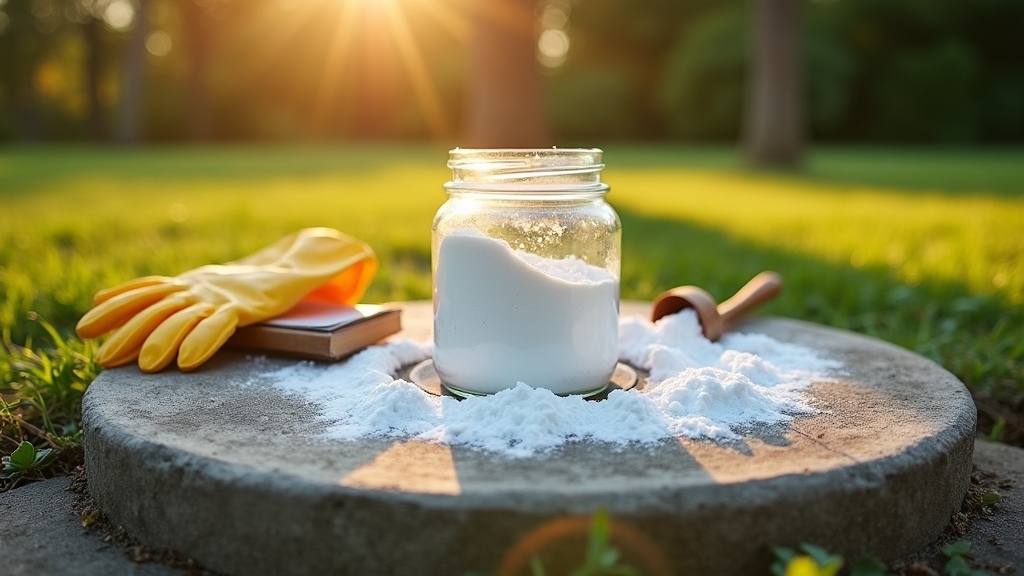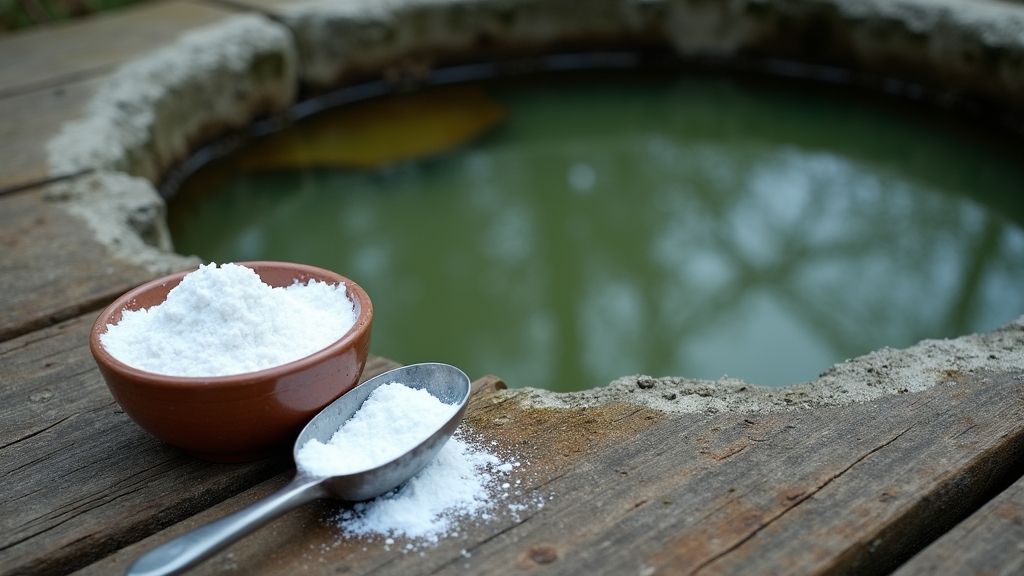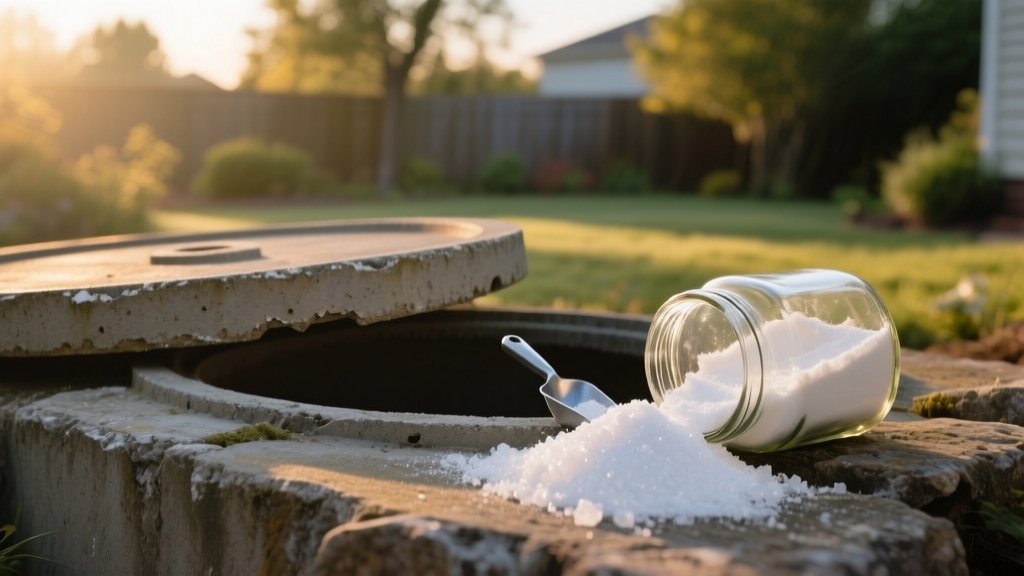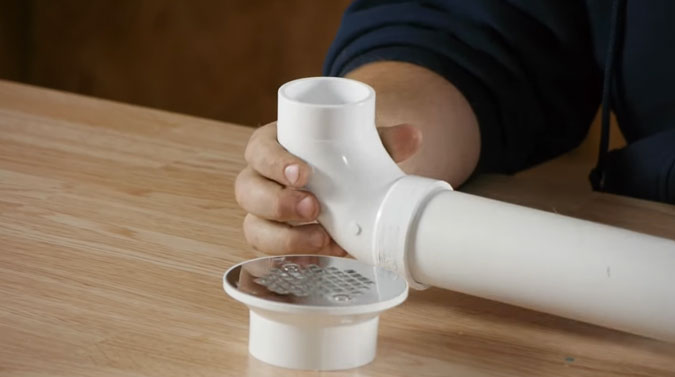You can safely use baking soda in your septic tank when applied in recommended amounts, such as about 1/2 cup weekly. It gently balances pH near neutral, supporting beneficial bacteria that break down waste while dissolving grease and neutralizing odors.
Baking soda won’t harm the microbial ecosystem if you avoid overuse and harsh chemicals. It supplements but doesn’t replace routine maintenance. Understanding its precise effects and application methods helps you optimize septic performance and system longevity.
Key Takeaways
- Baking soda is safe for septic tanks when used in recommended doses, supporting beneficial bacteria without harming the system’s microbial balance.
- It gently raises pH to a mildly alkaline level, optimizing conditions for bacterial waste decomposition and preventing harmful acidity.
- Weekly or monthly applications (~1/2 cup) help dissolve grease, neutralize odors, and maintain septic system health naturally.
- Overuse can disrupt chemical balance and bacterial activity, so proper dosing and moderate use are essential for safety.
- Baking soda complements routine septic maintenance but does not replace mechanical cleaning or pumping requirements.
Understanding the Role of Baking Soda in Septic Systems
Although baking soda is commonly found in household cleaning, its role in septic systems centers primarily on maintaining chemical balance and supporting bacterial activity.
With a pH near 8.1, baking soda acts as a mild alkaline agent that neutralizes excessive acidity in wastewater, helping keep the septic environment near neutral pH—optimal for bacterial waste decomposition. This pH buffering prevents corrosive conditions that could damage tank components.
Additionally, baking soda functions as a gentle abrasive and natural cleaner, aiding in grease dissolution within pipes, which reduces clog risks. It also supports growth of beneficial bacteria that break down waste, enhancing overall system efficiency.
While direct scientific studies on baking soda’s full septic impact are limited, fundamental chemistry supports its buffering and cleaning roles. However, use should be measured to avoid unfavorable pH shifts, and professional advice is advisable before routine application.
Using baking soda in moderation can complement other energy-efficient water system practices that help maintain system balance and efficiency.
How Baking Soda Interacts With Septic Tank Bacteria?
You rely on baking soda to maintain an essential pH balance in your septic tank, which is vital for sustaining bacterial activity. Its alkaline properties help neutralize excess acidity, creating an environment where beneficial bacteria can efficiently break down waste.
Maintaining the correct pH levels is crucial because septic system health impacts odor and waste breakdown efficiency. Proper maintenance also involves regular inspection and servicing, similar to the disassembly procedures used to check submersible pumps for optimal function.
Baking Soda and Bacteria
When managing a septic tank, understanding how baking soda interacts with the bacterial ecosystem is essential for maintaining system efficiency. Baking soda is non-toxic to beneficial bacteria, preserving their ability to break down waste. Its mild alkalinity supports a stable environment, avoiding bacterial death common with harsh chemicals.
| Aspect | Effect of Baking Soda | Impact on Bacteria |
|---|---|---|
| Toxicity | None at household doses | Bacteria remain viable |
| pH Influence | Mildly alkaline (around pH 9) | Supports bacterial metabolism |
| Organic Waste Breakdown | Indirectly enhanced | Efficient decomposition |
| Odor Control | Neutralizes odors | Prevents bacterial inhibition |
Using baking soda responsibly sustains bacterial populations critical for septic health. It is important to consider chemical compatibility when introducing substances to septic systems to avoid disrupting bacterial activity.
pH Balance Effects
How does baking soda influence the pH balance within a septic tank, and why does this matter for bacterial health? Baking soda’s pH of about 9 gently raises the tank’s pH to a neutral or mildly alkaline range, which is essential for maintaining bacterial enzyme activity.
This stable pH environment supports natural waste breakdown without harming beneficial bacteria. Proper maintenance of pH levels is as crucial as regular inspections in plumbing systems to prevent long-term issues. Specifically, you’ll find that:
- Baking soda buffers acidity, preventing harmful pH swings caused by household chemicals or organic waste.
- Its mild alkalinity avoids the corrosive effects seen with harsher alkaline agents, preserving bacterial populations.
- Regular small doses help sustain ideal pH, enabling bacteria to efficiently degrade solids and maintain system function. Maintaining a neutral pH level is crucial because it fosters optimal bacterial growth and activity within the septic tank.
Bacterial Activity Support
Although harsh chemicals like bleach and ammonia can devastate septic tank bacteria, baking soda offers a safe alternative that supports microbial health. Baking soda’s mild alkalinity (pH 8.1–9) helps neutralize excessive acidity, fostering an ideal environment for bacteria responsible for organic waste breakdown.
Unlike chemical cleaners, it doesn’t inhibit bacterial metabolism or disrupt nutrient uptake. Weekly applications of about 1/4 cup maintain favorable pH levels, sustaining microbial longevity and activity.
Additionally, baking soda neutralizes odors without producing toxic byproducts, indirectly reducing bacterial stress and promoting system stability. This gentle approach parallels the importance of proper maintenance found in durable bathtub materials to ensure long-term system health.
When combined with natural acids like vinegar, it forms a gentle cleaner that removes grime without harming bacterial colonies. Regular use of baking soda also helps prevent clogs and reduces septic tank pumping emergencies.
Benefits of Using Baking Soda for Septic Tank Maintenance
Since maintaining a balanced pH and clear pipes is essential for septic system efficiency, using baking soda offers multiple benefits for septic tank maintenance.
You’ll find it effective in:
- Dissolving and Preventing Pipe Buildup: Baking soda breaks down grease and organic matter, reducing clogs and ensuring smooth wastewater flow, which prevents plumbing backups. Its compatibility with corrosion-resistant materials helps extend the life of plumbing fixtures and pipes.
- pH Balancing and Bacteria Support: Its mildly alkaline nature neutralizes excessive acidity, fostering beneficial bacterial activity vital for decomposing solids and prolonging tank lifespan. It also protects pipes and tank components from corrosive damage.
- Odor Control: Baking soda neutralizes unpleasant septic odors without harming bacteria, enhancing air quality around the system. This natural solution aligns with eco-friendly practices by avoiding harsh chemicals that could disrupt septic function.
Safe Methods for Applying Baking Soda in Septic Tanks

You should apply about 1/2 cup of baking soda weekly by flushing it down the toilet to maintain ideal pH levels in your septic tank. Regular use of baking soda helps support the biological processes within the tank that are essential for waste breakdown.
Use it directly or combined with natural acids like vinegar for effective cleaning without disturbing bacterial balance. Avoid excessive doses or frequent heavy use to prevent disrupting the tank’s microbial environment.
Proper Dosage Guidelines
When managing your septic tank, applying baking soda in carefully measured doses guarantees you maintain the ideal chemical and bacterial balance. Typically, use 1 cup per 1,000 gallons of tank capacity, adjusting proportionally for smaller tanks.
Overuse risks pH imbalance, harming essential bacteria. Maintaining chemical balance is crucial to prevent damage to the septic system’s microbial environment. Follow these dosage guidelines:
- Apply monthly for maintenance to control odors and support bacteria. Regular use helps maintain bacterial balance in the septic system.
- Dose weekly into drains during low water use periods, preferably evenings.
- When mixing with natural additives like vinegar, use small quantities to avoid abrupt pH shifts.
Avoid exceeding recommended amounts and consult local guidelines for tank-specific recommendations. Monitor system performance and adjust dosage cautiously, increasing incrementally only if odors persist.
Application Techniques
Maintaining the correct dosage of baking soda sets the foundation for its effective use in septic systems, but applying it safely requires specific techniques to protect bacterial balance and system integrity. You should mix baking soda with natural agents like vinegar and lemon juice, such as 1/4 cup baking soda, 1/2 cup vinegar, and 2 tablespoons lemon juice, to create septic-safe cleaning solutions for drains and toilets.
When unclogging, combine baking soda with hot water and a small amount of vinegar to preserve beneficial bacteria. It is important to avoid adding yeast, septic bacteria, or baking soda in excessive amounts as they can harm microbial processes do not add yeast.
Apply baking soda gently around toilet bowls to avoid disrupting microbial activity. Always flush baking soda slowly to allow bacteria to adjust, and never exceed recommended quantities. Avoid harsh chemicals and heavy applications after septic pumping to maintain system stability and promote ideal waste breakdown.
Frequency Recommendations
How often should baking soda be applied to optimize septic tank health? The recommended frequency is once per month. This schedule maintains bacterial balance, neutralizes odors, and enhances waste breakdown effectively without disrupting the microbial ecosystem.
Regular application of baking soda supports the natural bacterial activity crucial for the septic system’s efficiency and longevity, which helps maintain septic tank health. Applying treatments consistently helps prevent issues similar to those caused by temperature fluctuations in pipe systems.
To apply baking soda safely and efficiently, follow these guidelines:
- Dose approximately 1 cup per 1,000 gallons of tank capacity during low water usage periods (evening or night) to maximize impact.
- Maintain consistent monthly intervals to support ongoing bacterial activity and prevent septic system emergencies caused by bacterial disruption.
- Combine monthly baking soda treatments with routine physical maintenance, including inspections every 1–2 years and pumping based on system needs, to ensure overall longevity and functionality.
Potential Risks and Limitations of Baking Soda Use

Although baking soda is generally safe for septic systems, overusing it or applying it in high concentrations can disrupt the chemical balance and temporarily impede bacterial activity essential for waste decomposition.
While baking soda is non-toxic and doesn’t kill beneficial bacteria at typical use levels, excessive application may alter septic tank chemistry and interfere with natural bacterial processes. It doesn’t replace necessary mechanical maintenance like pumping or professional inspection. Relying solely on baking soda can mask underlying problems and delay corrective action.
Additionally, frequent or high-dose use might contribute to sludge buildup or disrupt settling dynamics, potentially stressing system structure. Experts caution against viewing baking soda as a thorough treatment; it serves best as a supplementary cleaner. Avoid mixing it with other chemicals, which can cause unpredictable reactions affecting system health.
Selecting the appropriate components, such as valve flow directions, in septic system design can also influence overall system efficiency and health.
Comparing Baking Soda to Harsh Chemical Cleaners
When you compare baking soda to harsh chemical cleaners, the differences in their effects on septic systems become clear. Baking soda acts as a mild abrasive and pH balancer without harming beneficial bacteria, which are vital for waste breakdown. Its gentle action reduces the risk of corrosion and mechanical stress within the plumbing system.
In contrast, chemical cleaners contain corrosive agents like sulfuric acid and bleach that kill these microbes, disrupt system function, and damage pipes. Consider these points:
- Microbial Impact: Baking soda preserves septic bacteria, while chemicals destroy them, risking blockages and costly repairs. Regular use of baking soda aligns with proper maintenance that helps sustain system health and longevity.
- Pipe Integrity: Baking soda is non-corrosive; harsh chemicals generate heat and gas that degrade plumbing materials.
- Safety and Maintenance: Baking soda supports ongoing septic health and is safe for regular use; chemical cleaners pose environmental and structural hazards.
Environmental Advantages of Baking Soda in Septic Care
Because maintaining a balanced pH is essential for septic system efficiency, baking soda plays an indispensable environmental role by stabilizing tank acidity and preserving beneficial bacteria.
You’ll find that its buffering capacity prevents excess acidity, protecting microbial colonies critical for organic waste decomposition. This stabilization enhances sewage treatment efficiency and extends system lifespan.
Additionally, baking soda neutralizes corrosive acidic wastewaters, safeguarding tank components and pipes from damage. It also reduces grease buildup, preventing clogs that cause backups and environmental leaks.
By controlling odors naturally, it limits harmful gas emissions and minimizes chemical masking agents, reducing ecological chemical loads. Baking soda neutralizes foul smells by absorbing odorous compounds, making homes fresher and healthier Reduce Odours.
Being non-toxic, baking soda supports sustainable septic management, preventing groundwater and soil contamination. Using it promotes a resilient, efficient septic system while aligning with environmentally responsible practices.
Frequently Asked Questions
Can Baking Soda Help Fix a Septic System Backup?
Baking soda can’t fix a septic system backup caused by solids or mechanical failures. It helps prevent minor clogs by dissolving grease and neutralizing acidity, supporting beneficial bacteria.
You can use it as part of routine maintenance to reduce odors and buildup, but it won’t resolve serious backups. For emergencies, you need professional septic service. Rely on baking soda only as a preventive measure, not a cure for major septic issues.
Is Baking Soda Effective Against Septic Tank Root Intrusion?
Baking soda isn’t effective against septic tank root intrusion. It lacks the chemical properties needed to kill or deter roots invading pipes or tanks. You’ll need specialized mechanical removal or chemical root killers designed for root control.
Baking soda mainly helps with odor control, grease breakdown, and pH balance but doesn’t address root growth. Rely on professional treatments for root intrusion rather than household additives like baking soda.
How Often Should Baking Soda Be Added to Septic Tanks?
Think of baking soda as the gentle gardener for your septic tank; you should add about one cup weekly to maintain pH balance effectively. Alternatively, mixing one cup of baking soda with an equal amount of vinegar monthly can support system health.
Avoid overuse, as excessive amounts disrupt bacterial activity. Consistent, moderate dosing tailored to your household size and usage keeps the bacterial environment stable, preventing septic issues without harming system chemistry.
Can Baking Soda Cause Foam Buildup in Septic Tanks?
No, baking soda itself doesn’t cause foam buildup in septic tanks. Foam typically results from surfactants in detergents, which stabilize bubbles. Baking soda is alkaline and neutralizes acids but doesn’t act as a surfactant or produce foam.
Using moderate amounts helps maintain bacterial balance, indirectly reducing foam caused by organic buildup. However, avoid excessive doses to prevent disrupting tank chemistry, though documented cases of baking soda generating foam are lacking altogether.
Does Baking Soda Affect Septic Tank Inspection Results?
You won’t find baking soda negatively impacting septic tank inspection results. It doesn’t kill beneficial bacteria or disrupt sludge and scum layers critical for system evaluation. Instead, baking soda helps keep pipes clear and odors down, which may reflect positively during inspection.
However, avoid additives that cause frothing or solids agitation. Baking soda alone maintains system balance and doesn’t interfere with the parameters inspectors assess, such as sludge depth and bacterial health.
Protect Your Septic Tank System While Supplementing Maintenance
Just as a skilled gardener knows when and how to nurture soil without overwhelming it, you should use baking soda judiciously in your septic tank. Its mild alkalinity can support bacterial health and system balance, unlike harsh chemicals that risk destruction.
However, overuse may disrupt microbial activity, so precise application is key. By choosing baking soda wisely, you embrace a safer, environmentally sound approach, much like tending a delicate ecosystem rather than imposing brute force.


